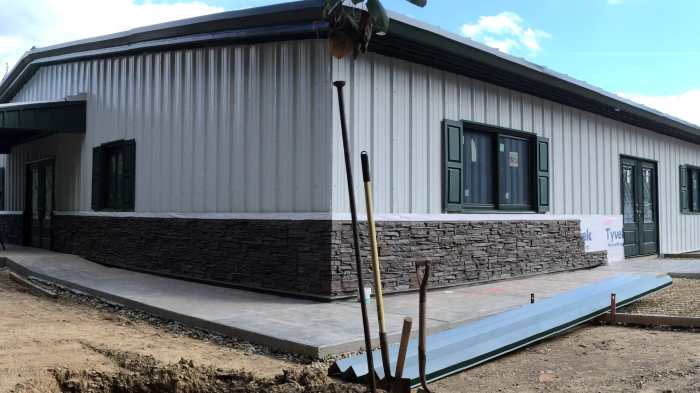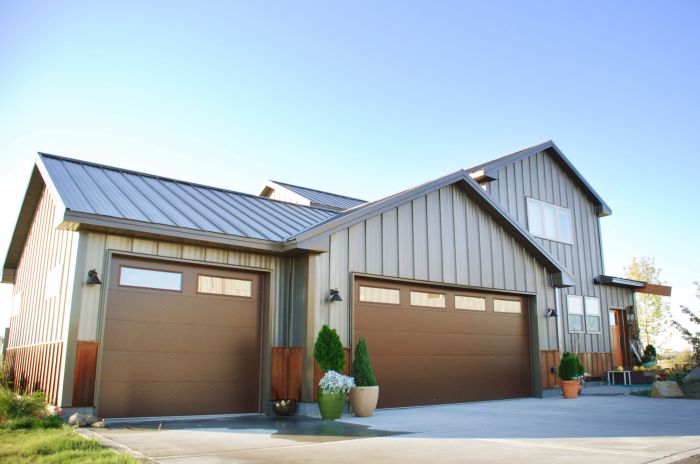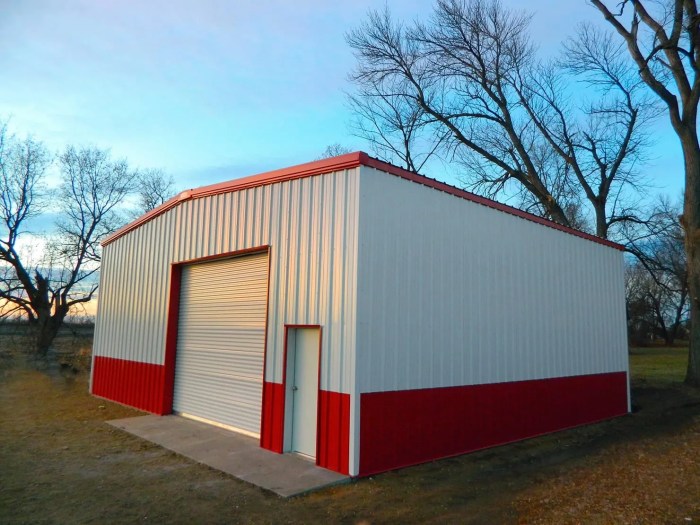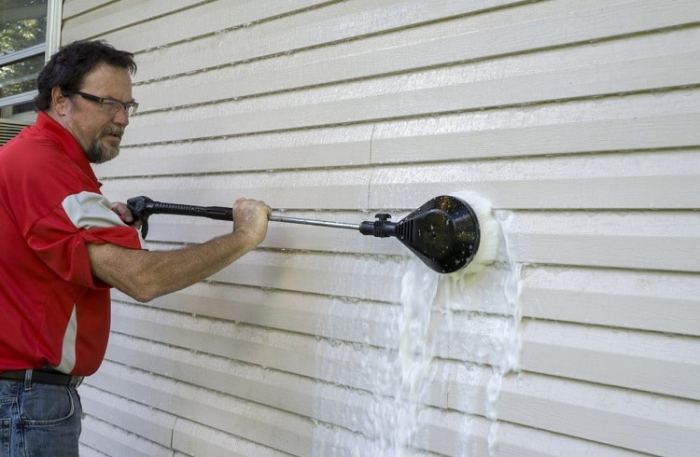Exterior metal siding presents a compelling blend of durability, aesthetics, and sustainability, making it a popular choice for homeowners seeking a long-lasting and visually appealing exterior. This guide delves into the multifaceted world of metal siding, exploring diverse materials, installation techniques, cost considerations, maintenance strategies, and environmental impact. We’ll uncover the nuances of various metal types, from the classic appeal of aluminum to the modern elegance of zinc, examining their respective lifespans and maintenance needs. We’ll also navigate the intricacies of installation, providing a step-by-step guide to ensure a successful project, and discuss the long-term cost-effectiveness and environmental considerations.
From understanding the different installation methods and required tools to exploring design considerations and color palettes, this comprehensive guide equips you with the knowledge needed to make informed decisions about your home’s exterior. Whether you’re a homeowner embarking on a renovation project or a professional seeking to expand your expertise, this resource provides valuable insights into the world of exterior metal siding.
Types of Exterior Metal Siding

Metal siding offers a durable and aesthetically versatile option for home exteriors. Its longevity, low maintenance, and resistance to various weather conditions make it a popular choice among homeowners. This section will delve into the specifics of different metal siding materials, their respective properties, and design applications.
Aluminum Siding
Aluminum siding is lightweight, relatively inexpensive, and readily available. Its corrosion resistance makes it suitable for various climates. However, it’s less durable than steel and can dent more easily. Typical lifespan ranges from 20 to 40 years, depending on the quality and environmental factors. Maintenance is minimal, usually involving occasional washing to remove dirt and debris. Aluminum siding is commonly available in various colors and finishes, offering design flexibility. A ranch-style home, for example, might benefit from the clean lines and classic appeal of horizontal aluminum siding in a muted gray or beige.
Steel Siding
Steel siding boasts superior strength and durability compared to aluminum. Its thicker gauge and higher tensile strength provide excellent resistance to dents and impacts. Galvanized steel, coated with zinc, offers exceptional protection against rust and corrosion, extending its lifespan to 40-75 years or even longer with proper maintenance. Steel siding requires minimal maintenance, primarily involving periodic cleaning. The robust nature of steel siding makes it a suitable choice for homes in areas prone to severe weather. A modern farmhouse could showcase the versatility of steel siding with a vertical profile in a deep charcoal gray, complementing the architectural style.
Zinc Siding
Zinc siding is a premium option known for its exceptional longevity and self-healing properties. The natural patina that develops over time adds unique aesthetic appeal, evolving from a silvery-gray to a darker, more nuanced tone. Zinc’s inherent corrosion resistance allows for a lifespan exceeding 100 years. While initially more expensive than aluminum or steel, its long lifespan and minimal maintenance needs can prove cost-effective in the long run. A contemporary home with clean lines could elegantly incorporate zinc siding in a horizontal profile, allowing the natural weathering process to add character over time. This would complement a minimalist aesthetic beautifully.
Copper Siding
Copper siding represents the pinnacle of luxury and longevity in metal siding. Its inherent resistance to corrosion, coupled with its beautiful, warm tones, makes it a highly sought-after material. Copper develops a distinctive green patina over time, adding character and visual richness. Its lifespan is practically indefinite, requiring minimal maintenance beyond occasional cleaning. However, the high initial cost makes it a less common choice. A Victorian-style home, with its ornate details, could dramatically benefit from the rich texture and color of copper siding, used perhaps in a shingle pattern to accentuate the building’s architectural character.
Comparison of Durability and Maintenance
The following table summarizes the durability and maintenance requirements of different metal siding types:
| Material | Durability | Maintenance | Lifespan (Years) |
|---|---|---|---|
| Aluminum | Moderate | Low | 20-40 |
| Steel | High | Low | 40-75+ |
| Zinc | Very High | Very Low | 100+ |
| Copper | Exceptional | Very Low | Essentially Indefinite |
Aesthetic Properties and Profile Examples
Metal siding is available in various profiles, each offering distinct aesthetic qualities. Horizontal profiles provide a clean, classic look, while vertical profiles create a more modern and sleek appearance. Shingle profiles offer a textured, traditional look, mimicking the appearance of wood shingles. The choice of profile significantly impacts the overall aesthetic of the home. For example, a craftsman-style home might benefit from the traditional charm of a horizontal profile, while a contemporary home could showcase the clean lines of a vertical profile. A rustic cabin could use a shingle profile to enhance its natural feel. The color choice also plays a vital role; a light-colored siding can make a home appear larger, while darker colors can create a more dramatic effect.
Installation Methods for Exterior Metal Siding
Installing exterior metal siding requires careful planning and execution to ensure a durable and aesthetically pleasing finish. Proper preparation, precise fastening, and meticulous attention to detail are crucial for a successful installation that protects your home for years to come. This section details the steps involved, from initial preparation to final finishing touches.
Preparation for Metal Siding Installation
Before beginning the installation, thorough preparation is paramount. This involves accurately measuring the area to be sided, ensuring the underlying structure is sound, and preparing the necessary materials. Begin by removing any existing siding, trim, or other obstructions. Inspect the sheathing for damage; repair or replace any rotted or damaged sections. Ensure the sheathing is clean, dry, and level. Properly installing flashing around windows and doors is essential to prevent water intrusion. Finally, install any necessary underlayment or vapor barriers according to manufacturer specifications. This meticulous preparation prevents future problems and ensures a long-lasting installation.
Step-by-Step Metal Siding Installation Guide
The installation process generally follows a consistent pattern, regardless of the specific siding type.
- Start at a Corner: Begin installation at a corner of the building, ensuring the first panel is perfectly aligned and level. This sets the foundation for the entire installation.
- Secure the First Panel: Use appropriate fasteners, typically self-tapping screws, to secure the first panel to the sheathing. Avoid over-tightening, which can damage the siding.
- Overlap Subsequent Panels: Install subsequent panels, ensuring proper overlap according to the manufacturer’s instructions. This overlap creates a weather-tight seal.
- Maintain Consistent Spacing: Maintain consistent spacing between panels and ensure vertical alignment throughout the installation. Use a level frequently to check for plumbness.
- Cut and Fit Panels: Around windows and doors, panels will need to be cut to fit. Use appropriate cutting tools (tin snips, circular saw with metal-cutting blade) and measure carefully to ensure a precise fit.
- Install J-Channel and Trim: Install J-channel around windows, doors, and corners to provide a neat finish and protect the edges of the siding. Use trim pieces as needed to complete the installation.
- Caulk and Seal: After installation, caulk all seams and joints to further prevent water penetration. Use a high-quality exterior-grade caulk.
Tools and Materials for Metal Siding Installation
Having the right tools and materials readily available is crucial for efficient and accurate installation. The following table Artikels the essential items:
| Category | Item | Quantity | Notes |
|---|---|---|---|
| Measurement & Marking | Measuring Tape | 1 | Accurate measurements are critical. |
| Measurement & Marking | Level | 1 | Ensure panels are installed plumb and level. |
| Cutting | Tin Snips | 1 | For cutting metal siding panels. |
| Cutting | Circular Saw (with metal blade) | 1 | For precise cuts on larger panels. |
| Fastening | Self-tapping screws | As needed | Choose screws appropriate for the siding material and building type. |
| Fastening | Drill/Driver | 1 | For efficient screw installation. |
| Finishing | Caulk | 1 tube | High-quality exterior-grade caulk is essential. |
| Safety | Safety Glasses | 1 pair | Protect eyes from flying debris. |
| Safety | Work Gloves | 1 pair | Protect hands from sharp edges. |
Best Practices for Ventilation and Water Management
Proper ventilation and water management are critical to prevent moisture buildup and potential damage. Adequate ventilation prevents condensation and helps maintain a dry interior environment. This is achieved by ensuring sufficient soffit and ridge vents. Water management involves proper flashing around windows and doors, as well as ensuring that panels are installed with sufficient overlap to prevent water penetration. Properly sloped sheathing helps to direct water away from the building. Paying close attention to these details will significantly increase the longevity of the siding and protect the underlying structure.
Cost and Benefits of Exterior Metal Siding

Choosing exterior siding is a significant investment impacting both the aesthetic appeal and long-term value of your home. Metal siding, while often perceived as a premium option, offers a compelling blend of durability, low maintenance, and energy efficiency that can translate into substantial cost savings over its lifespan. Understanding the initial and ongoing costs, along with comparing them to alternative materials, is crucial for making an informed decision.
Average Cost Breakdown for Metal Siding Installation, Exterior metal siding
The total cost of installing metal siding varies significantly depending on several key factors. Material selection, encompassing the type of metal (aluminum, steel, zinc), gauge (thickness), and finish (color, texture), plays a major role. Labor costs, influenced by the complexity of the project (e.g., intricate rooflines, large surface area), regional variations in labor rates, and the contractor’s experience, also contribute substantially. Finally, geographical location impacts both material and labor costs, with regions experiencing higher demand or limited access to materials potentially seeing inflated prices. A rough estimate for a typical 1,500 square foot home might range from $8,000 to $20,000 or more, including both materials and labor. This wide range highlights the importance of obtaining multiple detailed quotes from reputable contractors in your area.
Long-Term Cost Savings with Metal Siding
The initial investment in metal siding is often recouped over time through reduced maintenance and energy efficiency. Metal siding is incredibly durable, resistant to rot, insect infestation, and fire damage, minimizing the need for frequent repairs or replacements unlike wood or vinyl siding. This inherent durability translates to lower long-term maintenance costs. Furthermore, many metal siding options boast excellent energy efficiency properties. Their reflective surfaces can reduce heat absorption during summer months, lowering cooling costs, while their insulating properties can help retain warmth during winter, leading to reduced heating costs. These combined savings can significantly outweigh the higher upfront cost compared to less durable alternatives. For example, a homeowner in a region with extreme temperature fluctuations could potentially save hundreds or even thousands of dollars annually on energy bills.
Cost Comparison with Other Exterior Cladding Options
Understanding the cost-effectiveness of metal siding requires comparing it to other popular options. The following list summarizes the relative costs and benefits of various materials:
- Vinyl Siding: Generally the least expensive upfront, vinyl siding offers a lower initial investment but often requires more frequent maintenance and replacement due to its susceptibility to damage from impact and extreme weather. Its lifespan is significantly shorter than metal siding, leading to higher long-term costs.
- Wood Siding: While aesthetically pleasing, wood siding demands significant maintenance, including regular painting or staining, to prevent rot, insect damage, and weathering. This ongoing maintenance can quickly offset its initial cost advantage over metal siding.
- Brick Siding: Brick is a very durable and long-lasting material, but it comes with a considerably higher upfront cost than metal siding. While maintenance is minimal, the initial investment is significantly greater, making it less cost-effective in many cases.
- Fiber Cement Siding: This material offers a good balance of durability and cost, but still typically costs more than metal siding initially. While it requires less maintenance than wood, it’s not as low-maintenance as metal.
Maintenance and Repair of Exterior Metal Siding
Metal siding, while durable, requires regular maintenance to ensure its longevity and aesthetic appeal. Neglecting these tasks can lead to premature deterioration and costly repairs. A proactive approach to maintenance will significantly extend the lifespan of your siding and maintain its value.
Proper maintenance involves a combination of regular cleaning and periodic inspections to identify and address any potential problems promptly. This preventative approach is far more cost-effective than dealing with extensive damage later.
Cleaning Metal Siding
Cleaning metal siding is a straightforward process that should be undertaken at least once or twice a year, depending on your climate and environmental conditions. A simple solution of mild detergent and water, applied with a soft-bristled brush or sponge, is usually sufficient to remove dirt, grime, and pollen. For more stubborn stains, a pressure washer can be effective, but care must be taken to avoid damaging the siding’s finish by using too high a pressure or holding the nozzle too close. Always rinse thoroughly with clean water to remove all traces of detergent. Avoid using abrasive cleaners or harsh chemicals, as these can scratch or damage the protective coating.
Inspecting for Damage
Regular inspections are crucial for early detection of problems. Look for dents, scratches, rust, loose panels, and any signs of water damage. Pay close attention to areas around windows, doors, and corners, where damage is more likely to occur. Inspecting after severe weather events, such as hailstorms or high winds, is particularly important. Documenting any damage with photographs can be helpful when making insurance claims or planning repairs.
Repairing Minor Damage
Minor dents and scratches can often be repaired easily using a specialized metal siding repair kit. These kits typically include fillers and paints designed to match the color of your siding. For larger dents, a body filler may be necessary. Always follow the manufacturer’s instructions carefully. For more extensive damage, such as significant rust or holes, professional repair or replacement may be required. Remember to always use protective gear, such as gloves and eye protection, when undertaking any repairs.
Repairing Rust
Rust is a common problem with metal siding, particularly in areas with high humidity or salt spray. The first step in rust repair is to remove all loose rust using a wire brush or sandpaper. Then, apply a rust converter to neutralize the remaining rust and prevent further corrosion. Finally, prime and paint the affected area with a paint that is compatible with metal siding. For larger areas of rust, it might be more cost-effective to replace the affected panel.
Lifespan of Metal Siding
Metal siding is known for its exceptional durability and longevity, with a typical lifespan ranging from 30 to 50 years or even longer, depending on the material, quality of installation, and maintenance. Factors that can affect the lifespan include exposure to harsh weather conditions, such as extreme temperatures, heavy snowfall, and hail; the quality of the initial installation; and the frequency and effectiveness of maintenance. For instance, properly maintained metal siding on a house in a mild climate could easily last 50 years or more, while siding on a coastal property exposed to salt spray might require more frequent maintenance and have a slightly shorter lifespan. Regular maintenance is key to maximizing the lifespan of your metal siding and protecting your investment.
Environmental Impact of Exterior Metal Siding
Metal siding, while offering durability and aesthetic appeal, presents environmental considerations throughout its lifecycle, from manufacturing to disposal. Understanding these impacts is crucial for making informed choices about building materials and promoting sustainable construction practices. This section examines the environmental footprint of metal siding, focusing on its manufacturing process, recyclability, and energy efficiency.
The manufacturing of metal siding involves energy consumption for mining raw materials, processing, and transportation. The specific energy intensity varies depending on the metal type (aluminum, steel, zinc, copper) and the manufacturing processes employed. Steel production, for instance, is known to be energy-intensive, while aluminum production requires significant electricity. Furthermore, the manufacturing process can generate greenhouse gas emissions, including carbon dioxide and other pollutants, depending on the energy sources used and the efficiency of the manufacturing plants. Transportation of the finished product also contributes to the overall carbon footprint.
Recyclability of Metal Siding Materials
The recyclability of metal siding varies depending on the specific metal used. Steel and aluminum are highly recyclable materials, with established recycling infrastructure in many regions. Steel siding can be melted down and reused in various applications, including new steel products. Aluminum siding, similarly, has a high recycling rate, with minimal loss of material properties during the recycling process. Zinc and copper siding are also recyclable, although their recycling infrastructure might be less developed compared to steel and aluminum. However, the recycling process for all these materials requires energy, and transportation to recycling facilities contributes to emissions. The presence of coatings or other materials on the siding can sometimes complicate the recycling process, potentially reducing the recyclability rate. For example, if the metal siding is coated with paint or other materials, these need to be separated before recycling, adding to the complexity and cost.
Energy Efficiency and Carbon Footprint Reduction
Metal siding can contribute to energy efficiency and a reduced carbon footprint through its reflective properties. Light-colored metal siding, in particular, reflects a significant portion of solar radiation, reducing the amount of heat absorbed by the building’s exterior. This can lead to lower cooling costs during summer months. In colder climates, the insulating properties of the siding and the overall building envelope play a larger role in energy efficiency. The energy savings from reduced heating and cooling needs can offset some of the energy used in the manufacturing and transportation of the siding. The extent of energy savings depends on factors such as climate, building design, insulation levels, and the specific properties of the metal siding. A well-insulated building with highly reflective metal siding can significantly reduce energy consumption and greenhouse gas emissions compared to a building with less efficient materials. For instance, a study conducted by the [Insert Name of Reliable Organization] showed that buildings using light-colored metal siding experienced a [Insert Percentage]% reduction in cooling energy consumption compared to those using darker materials.
Design Considerations for Exterior Metal Siding

Metal siding offers a remarkable versatility in design, allowing homeowners to achieve a wide range of aesthetic goals. The choice of color, finish, and integration with other building materials significantly impacts the overall curb appeal and architectural style of a home. Careful consideration of these factors is crucial for a successful and visually appealing outcome.
Color and Finish Selection for Metal Siding
The color and finish of metal siding are paramount in shaping the home’s visual identity. A dark, matte black finish can create a modern, sleek appearance, while a lighter, satin-finish grey can evoke a more traditional feel. The selection should complement the surrounding landscape, architectural style, and personal preferences. Consider the following color palettes and finishes:
- Earthy Tones: Deep browns, greens, and greys create a natural, harmonious look, blending seamlessly with landscaping and offering a timeless appeal. Think of a deep charcoal grey siding complemented by warm brown trim, creating a sophisticated, understated elegance.
- Cool Neutrals: Shades of grey, beige, and white offer a clean, contemporary feel, ideal for modern or minimalist homes. A light grey siding with crisp white trim can amplify the sense of space and light.
- Bold Colors: For a more dramatic statement, vibrant colors like deep blues, reds, or greens can add personality and visual interest. However, these should be carefully considered to ensure they don’t clash with the surroundings or appear overwhelming.
- Finishes: Finishes range from matte to high-gloss, influencing the reflectivity and overall texture of the siding. Matte finishes minimize glare and create a more subdued look, while high-gloss finishes add a sleek, modern feel but can be more prone to showing imperfections.
Metal Siding Integration with Architectural Styles
Metal siding’s adaptability makes it suitable for diverse architectural styles.
- Modern: Clean lines, geometric patterns, and bold color choices are key to modern design. Metal siding, particularly in sleek, matte finishes and dark colors, perfectly complements this aesthetic. Imagine a home with charcoal grey metal siding, expansive windows, and minimalist landscaping.
- Traditional: Traditional styles often feature symmetrical facades, intricate detailing, and warm color palettes. Metal siding can be incorporated effectively by choosing earth tones, subtle finishes, and potentially incorporating wood accents to balance the metallic elements. A home with beige metal siding, white trim, and dark brown shutters would exemplify this style.
- Farmhouse: Farmhouse style embraces rustic charm and natural elements. Metal siding can contribute to this aesthetic by utilizing muted colors, such as muted greens or greys, and incorporating textures that mimic wood or stone. Imagine a home with a weathered grey metal siding, complemented by exposed beams and a large front porch.
Integrating Metal Siding with Other Building Materials
Careful planning is essential when integrating metal siding with other materials such as windows, doors, and trim.
- Window and Door Integration: Ensure proper flashing and sealing around windows and doors to prevent water damage. The choice of window and door colors should complement the siding color to create a cohesive look. Contrasting colors can be effective, but maintaining a balanced palette is key. For instance, dark bronze windows against light grey siding can create a striking contrast.
- Trim and Accents: The trim can be used to visually break up large expanses of metal siding and add architectural detail. Consider using contrasting colors or materials like wood or stone to create visual interest. For example, white or cream trim can highlight the clean lines of dark grey metal siding.
- Addressing Expansion and Contraction: Metal siding expands and contracts with temperature changes. Proper installation techniques, including expansion gaps and appropriate fasteners, are crucial to prevent buckling or damage. Failure to account for these movements can lead to issues with the siding’s longevity and aesthetic appeal.
Ultimately, the decision to choose exterior metal siding involves weighing various factors—aesthetics, budget, longevity, and environmental impact. This guide has provided a detailed overview of the essential considerations, from material selection and installation to maintenance and long-term cost savings. By understanding the nuances of each aspect, homeowners and professionals alike can make informed choices that best suit their needs and contribute to a beautiful and sustainable home exterior. Remember to consider your home’s architectural style, climate, and personal preferences when making your final decision. The right metal siding can transform your home’s curb appeal and provide years of worry-free protection.
FAQ Section: Exterior Metal Siding
What is the average lifespan of exterior metal siding?
The lifespan varies depending on the material and climate, but generally ranges from 30 to 50 years or more.
Can I install metal siding myself?
While possible for DIY enthusiasts with experience, professional installation is often recommended for optimal results and warranty coverage.
How much does metal siding cost compared to other materials?
Metal siding typically falls in the mid-range cost-wise, often more expensive than vinyl but less than brick or stone. The final cost depends heavily on material choice, labor costs, and project size.
Is metal siding prone to rust?
High-quality metal siding, especially those with protective coatings, are highly resistant to rust. However, damage to the coating can increase the risk.
How often should I clean my metal siding?
Annual cleaning with a gentle detergent and water is usually sufficient. More frequent cleaning may be necessary depending on environmental factors.



